Catalina Londoño and Alejandra Restrepo came all the way from Colombia, South America, to complete their PhDs at the University of Illinois. Catalina is an environmental economist who works on natural resources management and policy. Alejandra is a biologist who works on pollen analysis from tropical regions of the world, technically known as Palynology or Paleoecology, which is strongly tied to Paleontology.
They both are very loud and talkative roommates, just like many of the people from Latin America, who once in a blue moon talk about relevant things that are happening in their country and all over the world, while cooking and sharing their beloved Colombian dishes. I happen to live in the apartment beneath theirs and listened in on their interesting conversation.
~~*~~
Cata: Hey! You are late again! Look at the time! Were you still in the lab? I was starving so I got started with the cooking.
Aleja: I’m sorry. I was trying to finish my pollen-counting.
Cata: That sounds so boring! All day and all evening staring at the microscope … your job sucks a bit, doesn’t it?
Aleja: Not that much … I’m after something. Actually, I wouldn’t have come to this country if that was not the case.
Cata: Really? So what’s this “something” that is so special?
Aleja: Well, I want to figure out which plant species are going to handle the ongoing climate change well.
Cata: And you’re studying pollen to learn this? Ugh! First, that’s weird and second, how will this help you learn which plants are going to cope with global warming?
Aleja: It’s not weird. We are from the tropics. The highest number of plant and animal species live there. The future of the jungle is at risk!
Cata: I understand how climate change affects humans. Global warming means a loss of Páramos, which you know are the main source of water for our campesinos. There are serious consequences for people who live in coastal areas: as the sea level increases they will have no other option than migration to save their lives. Places susceptible to droughts and floods are becoming a serious danger for the establishment and future of communities. Forest fires are going to occur more frequently and we’ll be less able to get them under control. The effect will be more devastating in forests, and most importantly, in rural communities. I can keep going on about the negative effects on human beings, but you seem to care only about this crazy idea of plants surviving!
Aleja: Trees, actually. I want to know which tree species will adapt to high temperatures and dry conditions.
Cata: Is that more important than people struggling with the same stressful conditions?
Aleja: It may not as compelling, but it’s really fascinating. People will survive and adapt to these extremely hot summers and harsh winters. And you are right that the tropics will be especially hit by severe droughts and devastating floods.
Catalina suddenly shouted: That’s what I meant! Climate change is going to add another hurdle to people living in developing countries, but you think that plants surviving droughts are the most important thing on earth!
Aleja: Well, people might not cope with it, but biomes will. Plants have undergone periods even hotter than those we’re presently facing, back before humans evolved from apes.
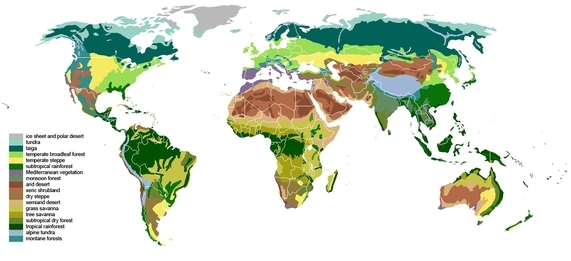
The main biomes in the world. Larger image here.
Aleja continued: The average global temperature on earth fifty million years ago was five degrees Celsius hotter than today. That’s nine degrees Fahrenheit. Carbon dioxide concentrations were way higher than the 350 parts per million that we’ve expelled to the atmosphere since the beginning of the Industrial era, but guess what lady: there were plants that totally adapted to those conditions.
Cata: Ha! That just sounds like so much science fiction. How could you possibly know this?
Aleja: Fossil pollen and fossil spores are the main tools used in our lab. Their structure is so resistant that it can be buried under hundreds of kilometers deep within the Earth’s crust and stored for millions of years. They preserve their original shape from when they were produced by flowering plants and ferns during reproduction. Imagine a bone of a dinosaur 100 million years old, but in this case it is the “sperm” of the plant and the fern that becomes a fossil.

Picture of an ancient and inactive volcano in Galapagos Islands located in San Cristóbal Island. The crater has been a reservoir of sediments accumulating pollen and diatoms for the last ten thousand years.
Cata: Yeah. Cool for a geologist, but I don’t get how it relates with your crazy — and sometimes very silly — imagination.
Aleja: Come on! It is absolutely possible to achieve! Every single pollen grain is different from the other. So anyone who is able to spend a bit of time with a microscope will be able to tell them apart:
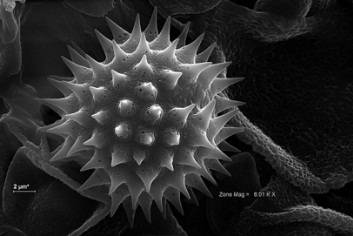
Some look like spiny balls…
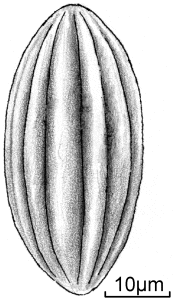
Some like footballs…

Some like little beans…
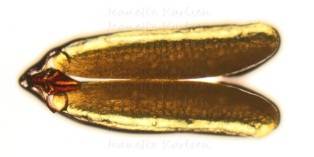
Some like bags full of those beans…
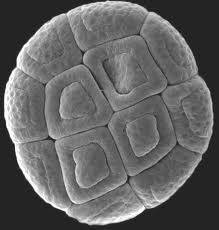
And others like the pattern of the quilt sewed by your grandma
Aleja [continuing]: But the coolest thing is that they sometimes show up in the fossil record, and then they disappear because those plants went extinct, just like dinosaurs did. Some other pollen and spore types appeared after the ones that went extinct because they evolved separately from those that are gone in the fossil record. I mean in the entire sequence of time.
Cata: So, is it possible for palynologists like you guys to track when those species became extinct and when new species arrived after evolution?
Aleja: Yes, and we compare those events with a record of chemical compounds also left in the same rocks and sediments from where we extracted the fossil pollen and spores. These compounds have varied with time and allow us to estimate the global mean temperature and the amount of rainfall back then. I just want to see which of those pollen types appeared after an increase in temperature and after a drop in rainfall, which reflects a hot and dry environment.
Cata: So those are your tropical plant and fern species that will survive ongoing global warming?
Aleja: Maybe … at least the living plants nowadays that are related to those that lived millions of years ago. This might give a clue to predict if there are any trees in the tropical forest that will survive a severe drought.
Cata: So something is going to survive. I am glad. Now that I think about it, the world as we know it is going to change a lot and perhaps you guys can give us policymakers on natural resources a better idea of how to manage the novel biomes that will come along with climate change. Your work is not that bad, actually.
Aleja: At least you and I find it useful now.
Their dinner ended at last, and I stopped my eavesdropping. It’s possible that finding answers to these questions might be too much to expect from just a pollen grain. Only time (as is usual in paleontology) and tons of pollen analysis will give Aleja the answers that she’s been seeking.
Written by Alejandra Restrepo, graduate student in Plant Biology, Dr. Surangi Punyasena’s Lab, University of Illinois.








